Nestled on a branch in the forests of Brazil lives a frog that may well be helping trees reproduce. It could be an inadvertent effort – the frog wants to sip nectar and covers its back with pollen in the process – but if it is helping trees reproduce, it’s the first pollinating frog ever recorded.
A paper noting the unusual frog behavior published earlier this year in the journal Food Webs, and the discovery emphasizes the diversity of pollinators and the importance of amphibians.
“It’s probably not the only case of this in the world, but it’s certainly significant in that it’s the first one that’s ever been discovered,” says JJ Apodaca, executive director of the national Amphibian and Reptile Conservation organization who was not part of the research team. “It’s really cool.”

Brazilian herpetologist Carlos Henrique de-Oliveira-Nogueira and a team first made the connection between the Xenohyla truncata frog and pollination in the scrubby, sandy ancient dunes off Brazil’s Atlantic coast.
The scientists were working on general amphibian and reptile monitoring when they saw the endangered tree frog.
Sips Nectar, Wiggles and Leaves
They knew an opportunity to watch a threatened species was rare, so they waited, watched, and were stunned to see them not only eating fruits but also diving headfirst into the flowers of Brazilian milk fruit tree and making “suction-like movements.”
The researchers speculated that the plant’s sweet nectar could be important fuel for the exhausting work of calling, arguing over territory and mating. But it wasn’t until they looked at pictures later that they discovered the frogs had pollen dotting their backsides and legs after emerging from the flowers. They looked much like bees and other flying pollinators who dip into flowers to drink nectar and pop out covered in plant reproductive dust.
“That caught our attention because, since the species usually visits various plants throughout the night, it could carry pollen from one flower to another and possibly play the role of a pollinator,” writes Henrique de-Oliveira-Nogueira.
Researchers need to do more work before Henrique de-Oliveira-Nogueira can say for sure if X. truncata is actually pollinating plants. It depends on if the pollen survives on the frog and if the frog visits enough plants.
But the chances are promising.
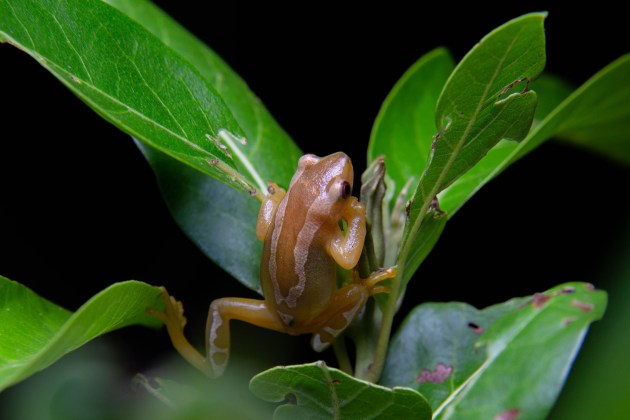
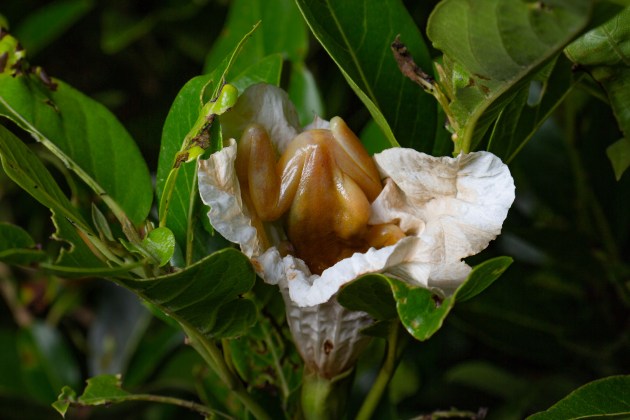

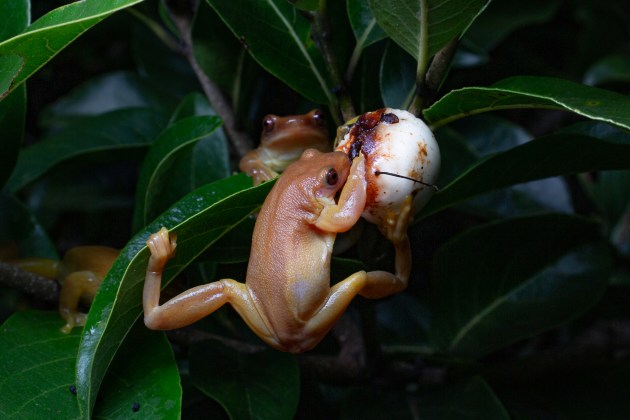
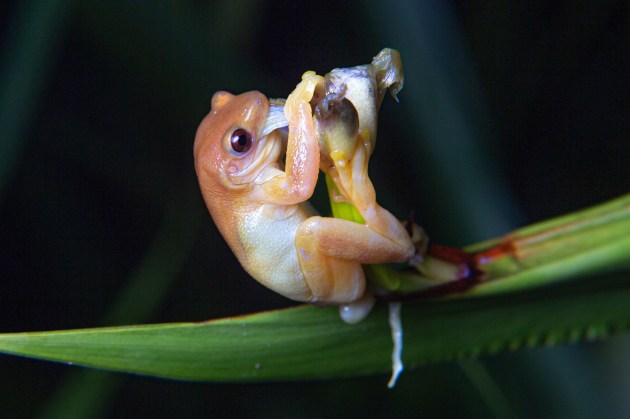
If the frogs are pollinating plants, it’s likely rare. Most frogs rarely visit the flowering portions of plants in the first place, and the ones that do aren’t always helping out. When the X. truncata frog, for example, visits the nonnative bearded iris flower, it eats its petals and can destroy the flower in the process.
But when the X. truncata frog enters the native Brazilian milk fruit tree’s white, cup-shaped flowers, it sips nectar, wiggles around in the pollen, then leaves.
“Xenohyla is the only species that actively seeks out fruits, and now, flowers and nectar for feeding. It is a unique case among amphibians.”
A Threatened Species
The frogs and the Brazilian milk fruit tree live in Brazil’s Restinga areas along the coast of the state of Rio de Janeiro in the northeastern part of the country. The region is part of the Atlantic Forest that “is heavily influenced by the sea,” writes Henrique de-Oliveira-Nogueira in an email to the Cool Green Science blog.
The sandy soil supports mostly shrubs where the X. truncata feeds on insects and fruits from four native plants and two flowers. They swallow the small fruits whole, then hop around leaving seeds behind in their droppings, effectively replanting the forests, another unusual characteristic in adult amphibians. The tiny frog reproduces in temporary ponds and finds shelter in tropical bromeliads.

Brazil lists the X. truncata frog as vulnerable to extinction and its populations are fragmented and scattered. Climate change looms over the frog as it does for countless other species, but the coastal, sandy areas the creature calls home are also facing rapid habitat loss through urban growth, real estate speculation and development.
“Every day we lose more Restinga areas, and along with those areas, we lose populations of Xenohyla.”
So Much Left to Discover
For Apodaca, the research adds to a growing list of the importance of amphibians across the globe.
“In a lot of ecosystems, amphibians in general are the most abundant vertebrate, so they act as a bridge between invertebrates and higher vertebrates,” he says. “In most areas, there’s more frog and amphibian biomass than all the other vertebrate biomass combined.”
In other words, frogs eat smaller creatures and bigger creatures eat frogs.
Maybe even more importantly, frogs move nutrients around. As tadpoles, they eat decaying leaves, plants and algae that accumulate in wetlands. Then as adults, they migrate out of the water where they eventually die or become a snack.
“They’re a major way that nutrients make it from wetlands back out into the landscape,” he says.
And they eat a lot of bugs, sometimes at levels high enough to qualify as pest control.
Frogs as pollinators are just another example of the myriad interactions between species we don’t yet know: “There’s still so much in the world left for us to understand and discover.”


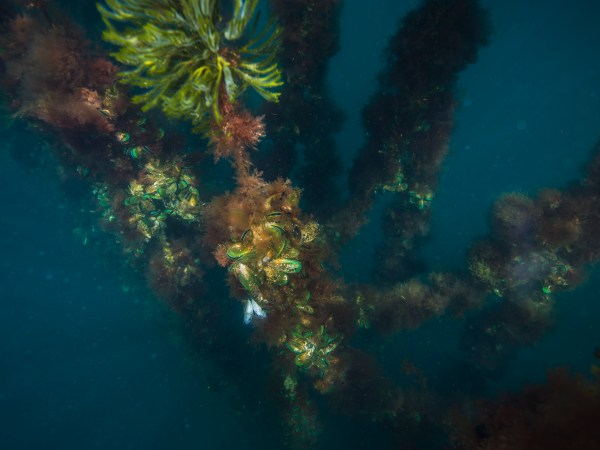

Join the Discussion